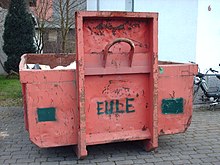Sliding roll-off container
In the waste management industry, a sliding roll-off container ( GAB for short , also roll-off trough ) is a substantially cuboid container made of sheet steel, reinforced on the outside by runners and ribs , in which waste and other bulk goods are transported.
functionality
The designation sliding roll-off container reflects the sequence with which a specially equipped truck sets down the container with a so-called hook lift.
When driving on the road, the container rests positively on the truck: With the slot between the middle of its 4 longitudinal runners, the container sits on 2 longitudinal rails (external dimensions approx. 70 cm) that protrude from the truck frame. At least a pair of bolts are pushed far back across the direction of travel through the rails to the outside through the webs of the middle runners and lock the container here. The eyelet located at the top of the container at the front is formed by a U-shaped loop made of round steel with a diameter of about 5 cm and protrudes obliquely upwards. This is where the locked hook of the lift intervenes and is held in position hydraulically.
The L-shaped arm of the hook lift runs vertically down from its hook end in front of the container (1.5–2 m) and here with a right-angled bend horizontally between the rails to a little behind the middle of the loading length of the truck, where the arm is between them Rails is hinged with a transverse axis.
To set it down, the bolts are opened and the leg of the hook lift arm, which is still lying horizontally, is telescopically shortened by means of hydraulics, with which the container is slid about a third of its length, guided by the lubricated rails.
In a second step, the lift arm is hydraulically swiveled up and backwards. While the hook describes about a quarter circle, the container is lifted at the front, thereby tilted and at the same time pushed further back and rolls with its runners on the wide rollers on the truck behind the rail ends.
As a result, the container tilts until it rests on the ground with the rear ends of the runners, which can also be equipped with rollers here. When the hook lift arm is moved further, the front edge of the container is lifted over the rear edge of the truck and also set down on the ground. The container rollers can roll on a smooth, hard surface, possibly in prepared receptacles, in order to position the container well in relation to a system. If the rollers sink in a little on a softer surface, the parking brake on the truck can be opened and the truck can "drive out from under the container".
Since the hook on the eye has kink play, the container can still be maneuvered to a small extent by driving the truck. Finally, the hook fastener is opened, the hook is unhooked, the arm is shortened and folded in.
A container is picked up by the corresponding steps in the opposite direction.
Executions
Sliding roll-off containers differ among other things in their dimensions. Often they are about eight feet wide and up to seven feet long. There are bigger differences in height. In practice, you will find containers from about 0.6 m to 2.10 m in height. There are versions with a lockable lid and versions that are open at the top.
technology
According to DIN 30722, sliding roll-off containers are defined as transport troughs with a clear container length between 4 m and 7 m and a total length between 4.4 m and 7.4 m. Common to all types of construction is the eyelet on the front of the container which is used to hold the container by a truck equipped with a hook lift. The maximum permissible total weight of the filled container is 15 t . A door on the back, usually with two leaves, is used for loading and unloading.
use
In addition to transporting waste, sliding roll-off containers are also used to transport recyclable materials such as foils and paper , but also scrap metal or green waste. They are only suitable to a limited extent for types of waste with a high bulk density, such as building rubble, as the permissible total weight would be exceeded in view of the large loading volume.
The Marienhütte steelworks in Graz uses about 2 m high sliding roll-off containers for slag.
See also
Individual evidence
- ^ Klaus Cord-Landwehr: Introduction to waste management . 3. Edition. BG Teubner , Stuttgart 2002, ISBN 3-519-25246-5 , pp. 71 .
- ↑ a b Roll-off container according to DIN 30722-1. In: containertechnik.de. Retrieved March 19, 2015 .
- ↑ Scrap metal, container service, scrap, removal, dismantling of machines, clearing, transport of scaffolding parts - Jean Berends. (No longer available online.) In: jean-berends.de. Archived from the original on February 16, 2015 ; accessed on March 19, 2015 . Info: The archive link was inserted automatically and has not yet been checked. Please check the original and archive link according to the instructions and then remove this notice.
